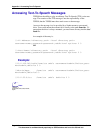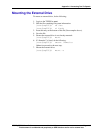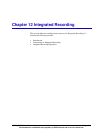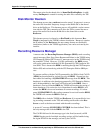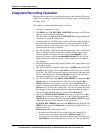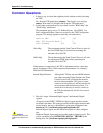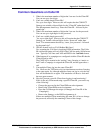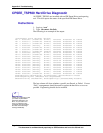
Appendix 12 Integrated Recording
Page 12-10 Version 4.0 CPSEE_TSP500 User Guide
This document is confidential and proprietary to SER Solutions and is not for external use.
Integrated Recording Operation
Integrated Recording involves sending messages to and from the TSP, gener-
ating a file, recording a conversation, and moving the audio recordings to the
recording server.
The sequence for Integrated Recording is as follows:
1. An agent is connected to a call.
2. The RRM issues a M_RECORD_CONTROL message to the TSP indi-
cating a “start recording” command.
3. The TSP issues an immediate M_COMPLETED message signaling the
acceptance or rejection of the request.
4. Assuming success – the TSP obtains a free conference block, and places
the audio from the Agent and Called Party into the conference. If the
agent was already in a conference, the output of the Agent’s conference is
placed into the recording conference.
5. The TSP generates a file name using the supplied key in the received Pro-
tocol C message and adds a three-digit sequence number and Alaw or
MuLaw identifier. Example: assume a key of recording0001. The
resulting file name would be recording0001.001.mu8, for the first file
name generated on a MuLaw system. Alaw systems will use “.al8” as
the extension.
6. The DSP attached to the Digital Station Trunk of the Agent (Station) per-
forms the recording.
7. The TSP allocates three buffers. Each buffer is 32,000 bytes will hold 4-
seconds worth of audio. Every 4-seconds, the TSP will receive a buffer
full event. The TSP will write the contents of the buffer to the audio snip-
pet file on the RAM disk. When one minute’s worth of audio has been
written, the snippet file is closed, and a new one opened.
8. The TSP will then send a M_MOVE_RECORDING command the Rec-
Watch daemon. In the message, the TSP will specify whether Rec-
Watch should move the snippet, as a single file to the RecServer, or
whether it should concatenate the snippet to a file already existing on the
RecServer. If a file does not already exist, one will be created using this
first snippet. In the concatenate mode, the sequence number is dropped
from the snippet filename when it is created on the RecServer.
9. Also in the M_MOVE_RECORDING message is a flag that tells Rec-
Watch if this is the last snippet or not. It is only on the last snippet that
RecWatch will respond to the TSP with an M_MOVE_DONE message.
When the TSP receives this message, it will forward an
M_DONE_RECORDING message to the RRM using the CTI link. The
RRM will then inform the RecServer server that the complete file is res-
ident on the server.
RecWatch performs other tasks as well:
• Monitors the RAM disk for files that have not been modified for
period of time (currently configured for fifteen seconds). It is
assumed that if this file has not been modified during this time, and
RecWatch has not been notified to move this file, then the TSP must



